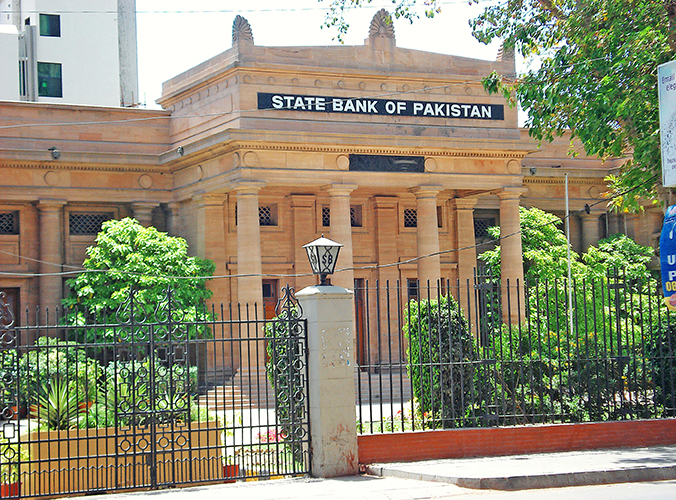If one visits the State Bank of Pakistan website, you can access a whole dedicated tab to the measures the SBP has taken in the middle of the Covid-19 crisis. It has slashed the interest rate by 625 basis points over the course of four months, with the benchmark discount rate down now to 7%. It has introduced refinancing schemes for housing finance, small and medium enterprises, microfinancing – and then extended these schemes all the way to September 2020. It has reduced the capital conservation buffer from 2.5% to 1.5%. Borrowing limits have increased; principal payments on loans can be deferred.
In short, the SBP is doing its best in the middle of a pandemic to say: “Please, go on and take a loan. Do not kill our economy. This is the best time to invest, trust us.”
Except, of course, no one is taking the bait.
As Syed Fawad Basir, a research analyst at Topline Securities, an investment bank, points out in a note sent to clients on July 7, the banking sector’s loan book only grew by 1% year-on-year, from Rs8.1 trillion in June 2019 to Rs8.2 trillion in June 2020.
And if you look at it on a monthly basis, the amount of loans outstanding actually declined 2% month-on-month, from Rs8.4 trillion in May 2020, to Rs8.2 trillion in June 2020. This, as Basir notes, is despite the aggressive cuts in interest rates by the central Bank since March 2020 and is at least partially reflective of the steep downturn in economic activity since the beginning of the pandemic.
“This is due to the impact of the pandemic Covid-19, which has caused the overall slowdown in the economic activity,” says Basir.
It is a view echoed by Amreen Soorani, research analyst and deputy head of research at JS Global Capital, another investment bank, in a note issued to clients on July 7.
“Banks remained reluctant with fresh lending. Despite various initiatives such as space in capital requirements, increase in borrowing limits and extension in regulatory credit limits announced by the SBP overall loan growth remained flat during the quarter,” Soorani said.
She added: “Moreover, lower interest rates have also not encouraged borrowing as yet as the sharp cuts have been a part of relief for the masses in the ongoing economic scenario.”
On the other hand, according to the latest central bank data, deposits in Pakistani banks have grown by 12% year-on-year, and 5% month-on-month to Rs16.23 trillion by June 2020.
In particular, in the second quarter of 2020, deposits increased by 7%. According to Basir this is higher than expected, and can be attributed to as Net Domestic Assets (NDA) of the banking system increasing by 6% during this period, on the back of an 11% increase in government borrowings to support the budget.
The combination of these two factors – deposits rising but lending staying flat – mean that the loans to deposits ratio dropped to 51% in June 2020, down from 56% in June 2019, and 55% in March 2020.
Basir expects the deposit growth to stay in the range of 10-11% during 2020, which roughly corresponds to the three-year historical average growth of 11%. However, lending is only expected to grow by around 5% during the year, which is significantly lower than the historical average three-year growth of 14%.
So where are all those deposits going, you may ask? Why, government bonds, of course. The banks’ investments in government bonds grew by 40% year-on-year through June 2020, and 3% in just the month of June, to Rs10.7 trillion.
According to Soorani: “During the quarter (the second quarter of 2020), the sector continued to lock in higher yielding assets amid sharp interest rate cuts and deployed deposits into government securities, leading to 40% year-on-year growth in investments,”
The currency in circulation, or CIC, increased by 17% to Rs6.19 trillion. CIC as a percentage of M2 (or money supply, which includes CIC, demand deposits, and foriegn deposits) stood at 31%. This is above the past 5-year average of 27%. And Pakistan’s CIC tends to be among the highest in the world. What this means is that Pakistanis are more likely to use physical cash than most other countries in the world.
Additionally, Basir noted in his report that their top picks remained MCB Bank, and Meezan Bank. While he did not cite a reason, this is inline with EFG-Hermes reports released in June, of which two praised MCB Bank specifically, noting its strong deposits and lending style, and one praising Meezan Bank for its strong capital buffers.
With the government’s voracious appetite for borrowing and the ease with which banks can deploy deposits into government bonds without significant capital requirements, it is no wonder that the banks are not willing to lend, least of all in the middle of a pandemic with constrained consumer and business spending resulting in declining revenues and cash flows across many businesses.
Yet this lack of willingness to lend has significant negative consequences for the economy: businesses that do need capital to continue their growth are not able to borrow, either the amounts they need or sometimes not at all. This, in turn, reduces economic activity to lower than it could be and causes overall economic growth to slow down.




















